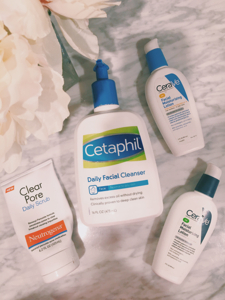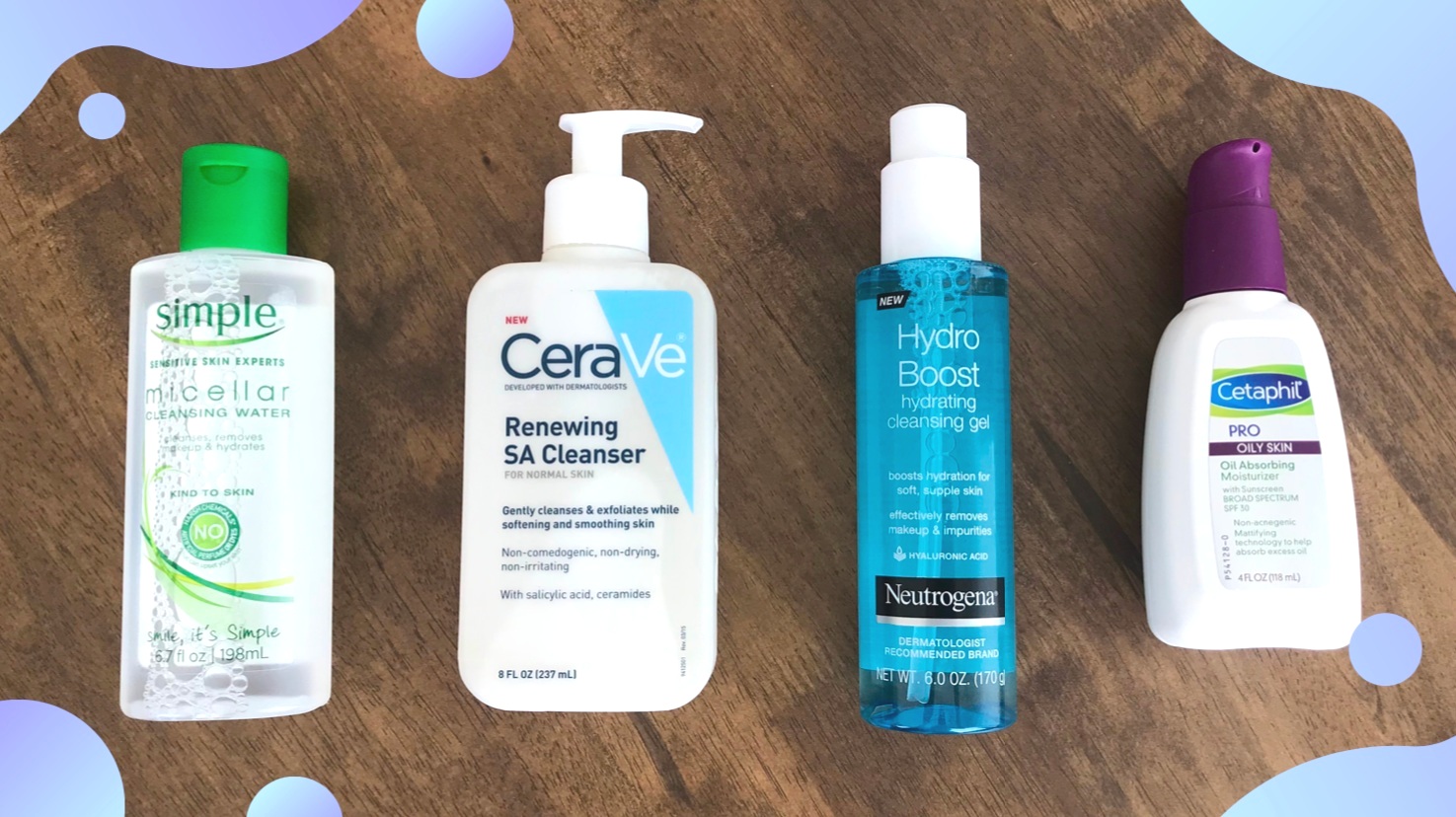Best Drugstore Skincare Routine for Acne-Prone Skin
Acne is one of the most common skin issues that many people face, and finding an effective skincare routine can feel overwhelming. While many turn to expensive treatments, a drugstore skincare routine for acne-prone skin can be just as effective and much more affordable. In this article, we’ll break down a simple yet powerful skincare routine using trusted, dermatologist-approved drugstore products that help keep acne under control without breaking the bank.
Introduction to Acne-Prone Skin
What Causes Acne?
Acne occurs when hair follicles or pores become clogged with oil, dead skin cells, and sometimes bacteria. The primary causes of acne include:
- Excess oil production: Overactive sebaceous glands can lead to an excess of oil on your skin, which clogs pores and leads to breakouts.
- Clogged pores: Dead skin cells can accumulate and block pores, which provides a breeding ground for bacteria.
- Bacteria: When pores are clogged, bacteria such as Propionibacterium acnes can multiply, causing inflammation and leading to acne.
- Hormonal changes: Changes in hormone levels, especially during puberty, menstruation, or pregnancy, can trigger acne outbreaks.
- Diet and stress: While these factors may not directly cause acne, they can exacerbate existing breakouts and inflammation.
Why Choose a Drugstore Routine?
Many people are surprised to learn that drugstore products can be just as effective as high-end skincare products for acne management. These affordable products are formulated with ingredients that have been proven to combat acne, such as salicylic acid, benzoyl peroxide, and niacinamide. Drugstore brands also have the benefit of being accessible and easy to find in most supermarkets and pharmacies, making them a convenient option for anyone seeking an acne treatment without the high price tag.
Morning Skincare Routine for Acne-Prone Skin
Step 1: Gentle Cleanser
Start your morning routine with a gentle cleanser that helps remove excess oil, dirt, and impurities without stripping the skin. Harsh cleansers can aggravate acne-prone skin by causing irritation and increasing oil production. Opt for a mild, non-foaming cleanser that maintains your skin’s natural moisture balance while cleansing effectively.
Recommended Products:
- CeraVe Hydrating Cleanser: This non-foaming cleanser is perfect for acne-prone skin. It helps hydrate while cleansing and is gentle on the skin.
- Vanicream Gentle Facial Cleanser: Free from fragrances and harsh chemicals, this cleanser is ideal for sensitive, acne-prone skin.
- La Roche-Posay Effaclar Purifying Foaming Gel: A great option for oily skin, this gel-based cleanser deeply cleanses without drying out the skin.

Step 2: Acne Treatment (Optional)
If you have active breakouts, adding an acne treatment to your morning routine can be highly beneficial. The most common acne-fighting ingredients are salicylic acid and benzoyl peroxide. These ingredients work to penetrate the skin, unclog pores, and reduce bacteria that cause acne.
Salicylic Acid (2%) is a beta-hydroxy acid (BHA) that helps exfoliate the skin, keeping pores clear. It’s particularly effective for mild to moderate acne.
Benzoyl Peroxide (2.5–5%) is another powerful acne-fighting ingredient that kills acne-causing bacteria. It’s often used in products for more severe acne outbreaks.
Recommended Products:
- CeraVe Acne Control Cleanser: Contains 2% salicylic acid to help treat acne and prevent new breakouts.
- Neutrogena On-the-Spot Acne Treatment: This product contains 2.5% benzoyl peroxide, which works to kill acne-causing bacteria quickly.

Step 3: Moisturizer
Even if you have oily, acne-prone skin, it’s crucial to use a lightweight, non-comedogenic moisturizer. Skipping this step can cause your skin to become dry and irritated, which may actually lead to more breakouts as your skin overcompensates by producing excess oil.
Recommended Products:
- Neutrogena Hydro Boost Water Gel: This gel-based moisturizer is oil-free and non-comedogenic, providing hydration without clogging pores.
- CeraVe PM Facial Moisturizing Lotion: A nighttime moisturizer that’s lightweight and non-comedogenic, perfect for soothing acne-prone skin.
- Avene Cleanance Hydra: Specially formulated for acne-prone skin, this moisturizer helps calm inflammation while providing hydration.

Step 4: Sunscreen
Using sunscreen daily is a must, especially if you’re using acne treatments that can make your skin more sensitive to the sun. Sun exposure can worsen acne scars and cause new dark spots to form, making it harder to achieve clear skin. Choose a sunscreen that’s oil-free, non-comedogenic, and designed for acne-prone skin.
Recommended Products:
- EltaMD UV Clear Broad-Spectrum SPF 46: A lightweight sunscreen that offers broad-spectrum protection while helping to calm acne-prone skin.
- La Roche-Posay Anthelios Clear Skin SPF 60: A high SPF sunscreen designed for oily, acne-prone skin that provides long-lasting protection without clogging pores.
- Moisturizers with SPF: Many moisturizers contain built-in SPF, which is great for simplifying your morning routine.

Evening Skincare Routine for Acne-Prone Skin
Step 1: Cleanser (Repeat Morning Cleanser)
Your evening routine starts by removing the buildup of sunscreen, dirt, and oil accumulated throughout the day. Repeat the cleansing step from your morning routine to ensure your skin is thoroughly clean.

Step 2: Acne Treatment or Retinoid
In the evening, you can add a stronger treatment, like a retinoid, to help prevent new breakouts and improve skin texture. Adapalene (Differin Gel) is a popular over-the-counter retinoid that can help with acne and signs of aging. Start by using it a few nights per week to build tolerance.
If retinoids are too harsh for your skin, you can continue using salicylic acid or benzoyl peroxide as part of your nighttime treatment.

Step 3: Moisturizer
Finish your routine with the same lightweight, non-comedogenic moisturizer you used in the morning. This will help lock in moisture and repair your skin’s natural barrier overnight.

Weekly Add-Ons for Acne-Prone Skin
Sulfur Mask for Oil Control and Inflammation
For an added boost in managing acne, consider using a sulfur mask 2-3 times per week. Sulfur is known for its ability to absorb excess oil, unclog pores, and reduce inflammation, making it ideal for acne-prone skin. These masks can help calm the skin and prevent future breakouts by balancing oil production.
Recommended Product:
- Mario Badescu Acne Facial Cleanser with Sulfur: A gentle sulfur-based mask that can be used weekly to keep acne at bay.
- Peter Thomas Roth Therapeutic Sulfur Masque: This mask contains 10% sulfur and works to treat acne while soothing inflammation.

Alcohol-Free Toner with Niacinamide
Niacinamide, also known as Vitamin B3, is a powerhouse ingredient for acne-prone skin. It helps to reduce redness, regulate oil production, and minimize the appearance of pores. An alcohol-free toner with niacinamide can help balance the skin’s pH, calm inflammation, and improve overall skin texture.
Recommended Product:
- The Ordinary Niacinamide 10% + Zinc 1%: A popular product that helps control oil and calm acne-prone skin, perfect for a toner step in your weekly routine.
- Paula’s Choice Skin Balancing Pore-Reducing Toner: Contains niacinamide and other soothing ingredients to reduce acne inflammation and control oil production.

Key Ingredients to Look For in Acne Skincare
Salicylic Acid
Salicylic acid is one of the most common and effective ingredients for treating acne. As a beta-hydroxy acid (BHA), it penetrates deep into the pores, dissolving dead skin cells and excess oil. This makes it an excellent choice for treating clogged pores, preventing new breakouts, and exfoliating the skin.
Example Products:
- CeraVe Acne Control Cleanser: Contains 2% salicylic acid to help cleanse the skin and reduce acne flare-ups.
- Neutrogena Oil-Free Acne Wash: A classic acne treatment that features salicylic acid to keep your skin clear and smooth.
Benzoyl Peroxide
Benzoyl peroxide is another key acne-fighting ingredient that targets the bacteria responsible for acne. It works by killing acne-causing bacteria, preventing future breakouts, and reducing inflammation. Benzoyl peroxide is particularly useful for those with more severe acne outbreaks.
Example Products:
- PanOxyl Acne Creamy Wash: Contains 10% benzoyl peroxide and is great for treating stubborn acne.
- Neutrogena On-the-Spot Acne Treatment: A spot treatment with 2.5% benzoyl peroxide to help clear up active pimples.
Adapalene (Retinoid)
Adapalene, a topical retinoid, is known for its ability to prevent acne by promoting skin cell turnover. This prevents pores from becoming clogged and reduces the occurrence of new breakouts. It also helps with skin texture, making it a great option for those who want to treat both acne and signs of aging.
Example Product:
- Differin Gel: Contains adapalene (0.1%) and is available over the counter as an effective treatment for acne and skin texture improvement.
Niacinamide
Niacinamide (Vitamin B3) is a must-have ingredient for acne-prone skin due to its anti-inflammatory properties. It reduces redness, soothes irritation, and controls oil production, making it an ideal ingredient for acne sufferers. Niacinamide can also minimize pore size and improve skin texture over time.
Example Product:
- The Ordinary Niacinamide 10% + Zinc 1%: This product helps control excess oil while calming acne-prone skin.
Ceramides
Ceramides are essential for maintaining a healthy skin barrier, especially for acne-prone skin. These lipids help retain moisture, prevent irritation, and support the skin’s natural defense system. Using products with ceramides can help balance the skin and keep it hydrated while reducing acne inflammation.
Example Product:
- CeraVe Hydrating Cleanser: Contains ceramides to support the skin’s barrier while gently cleansing.
Tips for Success in Managing Acne-Prone Skin
Consistency is Key
One of the most important things to remember when managing acne is that consistency is crucial. Sticking to your skincare routine for at least 8-12 weeks will give the products time to show visible results. Acne treatments take time to work, so don’t get discouraged if you don’t see immediate improvement.
Start Slowly with Active Ingredients
Introduce active ingredients such as salicylic acid, benzoyl peroxide, or retinoids gradually into your routine. Begin with a few nights a week and increase the frequency as your skin builds tolerance. This will help minimize irritation and ensure the products work effectively without overwhelming your skin.
Avoid Over-Washing
Washing your face too frequently or using harsh cleansers can strip the skin of essential oils, leading to dryness and irritation. This can make acne worse by causing your skin to overproduce oil. Stick to cleansing twice a day—morning and night—and always use a gentle cleanser.
Patch Testing New Products
Before adding a new product to your routine, always perform a patch test on a small area of your skin. This will help you avoid potential allergic reactions or irritation, especially if you have sensitive skin.
When to See a Dermatologist
Signs of Severe Acne
If your acne is severe, persistent, or worsening despite following a routine, it might be time to consult a dermatologist. They can provide personalized advice, recommend stronger treatments, and help you manage your acne more effectively.
Personalized Treatment Options
Dermatologists can prescribe topical or oral medications, such as antibiotics, oral contraceptives, or retinoids, depending on the severity of your acne. They can also offer professional treatments such as chemical peels or laser therapy to improve skin appearance and reduce breakouts.
Conclusion: Building Your Drugstore Skincare Routine for Acne-Prone Skin
Creating an effective skincare routine for acne-prone skin doesn’t have to be complicated or expensive. By choosing the right drugstore products that target acne’s root causes—such as excess oil, clogged pores, and bacteria—you can see significant improvements over time. Remember to be consistent, start slowly with active ingredients, and always prioritize gentle, non-comedogenic products.
Incorporating products like salicylic acid, benzoyl peroxide, niacinamide, and ceramides into your morning and evening routine can help keep acne under control and improve your skin’s overall health. Stick with it, and over time, you’ll see clearer, healthier skin.
FAQs
How long will it take to see results from my acne skincare routine?
Results typically take around 8-12 weeks to show, as acne treatments need time to work and clear up the skin. Be patient and consistent with your routine.
Can I use salicylic acid and benzoyl peroxide together?
While both are effective for acne, using them together can sometimes lead to irritation. If you’re new to these ingredients, try alternating them, or consult with a dermatologist to determine the best approach for your skin.
What should I do if my acne worsens despite using over-the-counter treatments?
If over-the-counter products aren’t working, consider seeing a dermatologist who can prescribe stronger medications or suggest alternative treatments like chemical peels or laser therapy.
